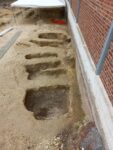 A large necropolis from the late Roman empire has been discovered under the wall of a supermarket in Arras, northern France. Archaeologists surveyed the site in advance of construction of an extension to the supermarket, and in July 2020 unearthed a lead sarcophagus that can by stylistically dated to the 4th century.
A large necropolis from the late Roman empire has been discovered under the wall of a supermarket in Arras, northern France. Archaeologists surveyed the site in advance of construction of an extension to the supermarket, and in July 2020 unearthed a lead sarcophagus that can by stylistically dated to the 4th century.
Archaeologists excavated further this fall and discovered that the necropolis extends beyond their remit. Only the southern perimeter of the 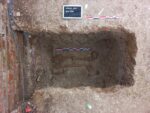 burial ground has been found. To the west, the graves continue under the supermarket. They continue eastward crossing into the neighboring property, and northward as well, albeit with less tomb density that suggests the northern perimeter is near.
burial ground has been found. To the west, the graves continue under the supermarket. They continue eastward crossing into the neighboring property, and northward as well, albeit with less tomb density that suggests the northern perimeter is near.
Most of the tombs are laid out along a southwest/northeast orientation, and while they are relatively densely packed together, there is almost no 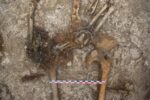 overlap between the cut graves. The burials unearthed so far are inhumations and they are notably devoid of grave goods. Only two graves contained any objects at all, most strikingly an adult woman buried with a rich array of jewelry including a pearl necklace, earrings, copper and bone bangles and copper finger rings.
overlap between the cut graves. The burials unearthed so far are inhumations and they are notably devoid of grave goods. Only two graves contained any objects at all, most strikingly an adult woman buried with a rich array of jewelry including a pearl necklace, earrings, copper and bone bangles and copper finger rings.
With the exception of one double burial containing the remains of one 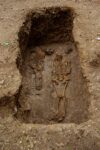 adult and one child, each grave held a single individual. Almost all of them were laid to rest in wood coffins, attested to by the surviving iron nails and metal brackets nailed to the corners of the grave’s wooden formwork. Even the two people buried together in one grave were each placed in their own wooden coffin.
adult and one child, each grave held a single individual. Almost all of them were laid to rest in wood coffins, attested to by the surviving iron nails and metal brackets nailed to the corners of the grave’s wooden formwork. Even the two people buried together in one grave were each placed in their own wooden coffin.
Another lead coffin was discovered, not far from where the one was found 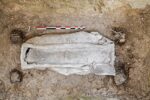 last year, with the same stylistic features that mark its date of manufacture. In the burial plot next to it was a limestone sarcophagus, its cover still in place, intact and so effectively a seal that no water had penetrated the interior. When archaeologists raised the lid, they found no sediment or water at all, just the skeletal remains of an adult female.
last year, with the same stylistic features that mark its date of manufacture. In the burial plot next to it was a limestone sarcophagus, its cover still in place, intact and so effectively a seal that no water had penetrated the interior. When archaeologists raised the lid, they found no sediment or water at all, just the skeletal remains of an adult female.
The individuals buried correspond, at first glance, to a natural recruitment. We meet children, including very young children, and adults; men and women. No particular distribution was observed according to the age of the deceased, the graves of children being mixed with the graves of adults.
Founded by the Belgic Atrebates tribe in the Late Iron Age, Arras was dubbed Atrebatum by the Romans when it was conquered by Julius Caesar 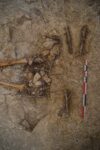 in 56 B.C. and made the capital of the Atrebates. It was also a castrum, a fort garrisoning Roman legions, as was targeted by Germanic tribes when they began their incursions into the territory in the late 3rd century. The city retracted to its defensive ramparts in response, but in the 4th century it remained an important military and commercial center, residence of the prefect of the Batavian mercenaries charged with the defense of northern Gaul and famed for its high-quality textiles that were exported throughout the Roman world.
in 56 B.C. and made the capital of the Atrebates. It was also a castrum, a fort garrisoning Roman legions, as was targeted by Germanic tribes when they began their incursions into the territory in the late 3rd century. The city retracted to its defensive ramparts in response, but in the 4th century it remained an important military and commercial center, residence of the prefect of the Batavian mercenaries charged with the defense of northern Gaul and famed for its high-quality textiles that were exported throughout the Roman world.
It was during this prosperous period in the 350s A.D., that Atrebatum was first evangelized by Saint Martin of Tours who had himself served in the Roman cavalry since he was a teenager. Any success he may have had fell by the wayside along with Arras’s prosperity come the 5th century. The city was all but destroyed by Germanic invaders during the Crossing of the Rhine (406-407 A.D.), and again by Atilla during the Hun invasion of Gaul in 451. Between the two events, the Franks, foederati of the Roman Empire, took control of the area. Evangelization resumed targeting the new Frankish masters when the Diocese of Arras was established in 499.
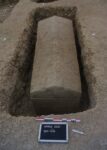
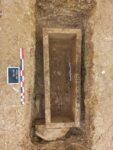 Excavations in the 1980s unearthed a large early imperial cemetery containing more than a hundred cremation burials from the 1st and 2nd centuries. These graves contain a variety of goods, including the remains of food offerings, coins, jewelry, grooming tools, pottery and glassware. The newly-discovered cemetery underscores the profound shift in funerary practices from the High Empire to the Late even among non-Christians.
Excavations in the 1980s unearthed a large early imperial cemetery containing more than a hundred cremation burials from the 1st and 2nd centuries. These graves contain a variety of goods, including the remains of food offerings, coins, jewelry, grooming tools, pottery and glassware. The newly-discovered cemetery underscores the profound shift in funerary practices from the High Empire to the Late even among non-Christians.
The biological study of the population will confirm or invalidate a natural recruitment of the buried population and supplement the observations made in the field concerning the organization of the sepulchral space according to the age and sex of the deceased.